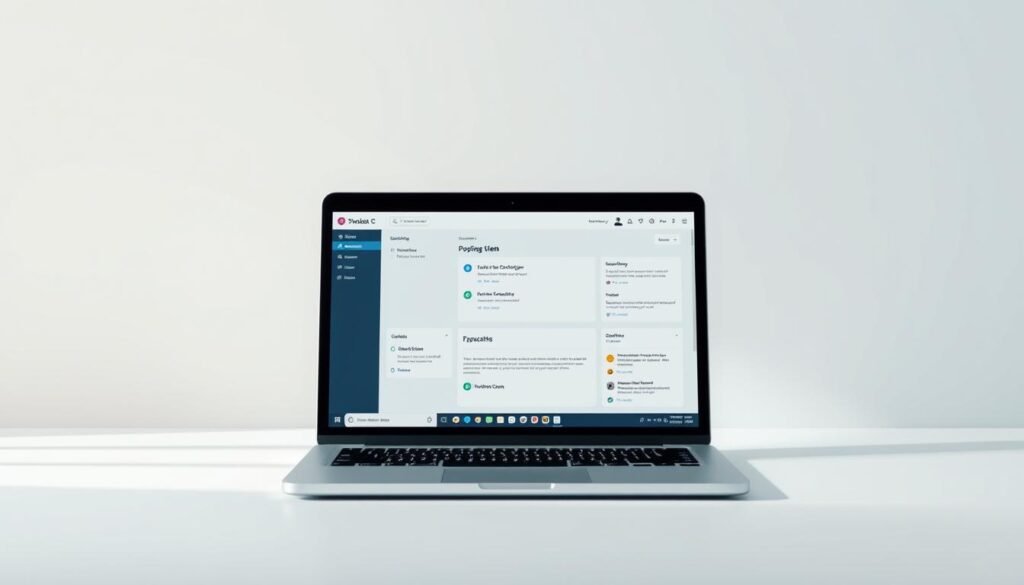Have you ever wondered why some apps feel effortless to use while others leave you frustrated? The answer lies in user experience design, a field dedicated to making products enjoyable, accessible, and intuitive. This discipline focuses on creating seamless interactions between users and digital or physical products.
Did you know that 62% of users are less likely to purchase from a brand after a negative experience? This statistic highlights the critical role of user experience in business success. It’s not just about aesthetics; it’s about understanding user needs and crafting solutions that meet them.
The term “user experience” was coined by Don Norman in 1988, marking the formalization of this essential field. Today, UX design is a cornerstone of modern product development, blending creativity, psychology, and technology.
In this article, we’ll explore the daily tasks, essential skills, and average salaries of professionals in this rewarding career. Whether you’re considering a path in design or simply curious about the process, this guide will provide valuable insights.
Key Takeaways
- User experience design focuses on creating seamless and enjoyable interactions.
- 62% of users are less likely to purchase after a negative experience.
- Don Norman coined the term “user experience” in 1988.
- UX design significantly impacts business success and customer satisfaction.
- Professionals in this field earn an average salary of $110k-$124k.
What is UX Design?
Every interaction with a product shapes how users perceive it. User experience design focuses on making these interactions seamless, enjoyable, and meaningful. It’s not just about aesthetics; it’s about understanding user needs and crafting solutions that meet them.
In 1988, Don Norman coined the term “user experience” while working at Apple. His work laid the foundation for modern UX principles, emphasizing usability, efficiency, and emotional response. These components ensure products are not only functional but also delightful to use.
Key elements of user experience design include A/B testing, personas, wireframes, and prototypes. A/B testing compares two versions of a product to see which performs better. Personas represent target users, helping designers empathize with their needs. Wireframes and prototypes are blueprints that guide the design process.
Unlike pure visual design, UX goes beyond surface-level appeal. For example, consider a hotel check-in process. Visual design focuses on the lobby’s look, while UX ensures the check-in process is quick, intuitive, and stress-free. This distinction highlights the importance of interaction design and accessibility.
UX design is inherently interdisciplinary, blending psychology, business, and technology. It bridges the gap between human behavior and technical solutions, ensuring products are both innovative and user-friendly. This holistic approach makes it a cornerstone of modern product development.
What Does a UX Designer Do?
Understanding user behavior is the cornerstone of creating effective digital products. Professionals in this field focus on crafting experiences that are intuitive, accessible, and enjoyable. Their work involves a mix of research, creativity, and technical skills to ensure products meet user needs.
Conducting User Research
User research is the foundation of any successful project. Methods like surveys, interviews, and A/B testing help gather valuable insights. For example, in the Foodies app case study, researchers discovered that users preferred a simplified navigation system. This feedback directly influenced the final design.
Creating personas is another critical step. These fictional profiles, like “Samantha,” represent target users. They help designers empathize with user needs and tailor solutions accordingly. This approach ensures the product resonates with its intended audience.
Creating Wireframes and Prototypes
Once research is complete, the next step is visualizing the product. Tools like Figma and Adobe XD are used to create wireframes and prototypes. Wireframes act as blueprints, outlining the structure and layout. Prototypes bring these designs to life, allowing for interactive testing.
Usability testing plays a vital role in iterative design. By observing how users interact with prototypes, designers can identify pain points and make improvements. This process ensures the final product is both functional and user-friendly.
Responsibilities can vary depending on the organization. In startups, professionals often wear multiple hats, handling everything from research to prototyping. In larger firms, roles are more specialized, with dedicated teams for each phase of the process.
Key Skills Every UX Designer Needs
Success in user experience hinges on a blend of technical expertise and interpersonal skills. Professionals in this field must master both to create intuitive and impactful designs. Let’s explore the essential skills that set top performers apart.
Technical Skills
Proficiency in tools like Figma is crucial for creating wireframes and prototypes. These tools help visualize user flows and test designs iteratively. User testing platforms like Maze and Hotjar provide valuable insights into user behavior, enabling data-driven decisions.
Data analysis is another critical skill. By interpreting user feedback and metrics, designers can refine their work to meet user needs effectively. Courses like the Google UX Certificate offer comprehensive training in these technical skills.
Soft Skills
Empathy is at the heart of user experience design. Understanding user pain points through journey mapping ensures solutions resonate with the audience. Effective collaboration with stakeholders and team members is equally important.
Strong communication skills are essential for presenting ideas and gathering feedback. Programs like UPenn’s Communications course can enhance this ability. Balancing these soft skills with technical expertise creates a well-rounded professional.
AI tools like ChatGPT are also becoming valuable for streamlining workflows. They assist in brainstorming, research, and even prototyping, making the design process more efficient.
The UX Design Process
Creating a seamless user experience involves a structured approach that balances creativity and functionality. The design process typically follows six stages: research, information architecture (IA), wireframing, testing, feedback, and delivery. Each phase ensures the final product meets user needs effectively.
For example, consider a shoe website. The research phase identifies user preferences, such as easy navigation and quick checkout. IA organizes content logically, ensuring users find what they need without frustration. Wireframing visualizes the layout, while testing uncovers usability issues.
Two methodologies dominate the process: waterfall and agile. Waterfall follows a linear sequence, ideal for projects with fixed requirements. Agile, on the other hand, emphasizes iterative development, allowing flexibility and continuous improvement. Both have their strengths, depending on the project scope.
A/B testing plays a crucial role in reducing feature creep. By comparing two versions of a feature, designers can identify which one performs better. This data-driven approach ensures the final product aligns with user expectations.
Sprint meetings are essential for collaboration. These sessions bring together designers, developers, and stakeholders to review progress and address challenges. Effective communication during these meetings ensures the project stays on track and meets deadlines.
Incorporating the Jobs-to-Be-Done (JTBD) framework alongside personas enhances the design process. JTBD focuses on the tasks users want to accomplish, while personas provide a deeper understanding of their motivations. Together, they create a user-centered approach that drives success.
Tools UX Designers Use
The right tools can transform a good design into an exceptional one. Professionals rely on a variety of design tools to streamline workflows and enhance creativity. From collaborative platforms to AI-powered solutions, these resources are essential for delivering high-quality user experiences.
Figma and Adobe XD are industry standards for collaborative work. Figma excels in real-time teamwork, allowing multiple designers to work on the same project simultaneously. Adobe XD, on the other hand, integrates seamlessly with other Adobe Creative Cloud apps, making it a favorite for those already in the Adobe ecosystem.
For rapid prototyping, tools like Marvel are invaluable. They enable designers to create interactive mockups quickly, saving time during the iterative process. AI-powered solutions like UXCam take it a step further by generating automated heatmaps, providing insights into user behavior without manual effort.
Free resources like FigJam are perfect for remote workshops, offering a collaborative space for brainstorming and planning. Additionally, platforms like Designlab offer discounts on design tools for students, making it easier for aspiring professionals to access the resources they need.
Mastering these tools is essential for success in user experience design. Whether it’s conducting user testing or creating prototypes, the right tools empower designers to deliver exceptional results.
UX Designer vs. UI Designer
While both roles focus on improving user experiences, their responsibilities differ significantly. A UX designer concentrates on the structure and functionality of a product, ensuring it meets user needs. On the other hand, a UI designer focuses on the user interface, crafting visually appealing and interactive elements.
For example, a UX designer creates wireframes to map out the product’s layout and flow. Meanwhile, a UI designer selects color palettes, typography, and icons to enhance the visual design. This collaboration ensures the product is both functional and aesthetically pleasing.
Salaries also reflect the distinction between these roles. According to Onward Search, the average salary for a UX designer is $104k, while a UI designer earns around $90k. This difference highlights the varying demands and expertise required for each position.
The handoff process between these roles is crucial. Once the UX designer finalizes the structure, the UI designer takes over to refine the user interface. In startups, professionals often take on hybrid roles, handling both interaction design and visual elements to streamline the process.
Transferable skills between these disciplines include problem-solving, creativity, and attention to detail. Whether focusing on usability or aesthetics, both roles contribute to creating products that users love.
Day in the Life of a UX Designer
From analyzing data to refining prototypes, the daily routine of a UX expert is anything but monotonous. Each day is packed with diverse tasks that require creativity, problem-solving, and teamwork. Whether working in-house or at an agency, the schedule is both structured and flexible.
Mornings often start with reviewing data from tools like Hotjar. Analyzing live test results helps identify user pain points and areas for improvement. This data-driven approach ensures decisions are grounded in real user behavior.
Midday is dedicated to user testing. Remote usability sessions via platforms like Lookback allow designers to observe how users interact with prototypes. These insights are invaluable for refining designs and ensuring they meet user needs.
Afternoons are reserved for collaboration. Presenting findings to stakeholders using tools like Miro ensures everyone is aligned. Working closely with PMs and developers fosters a cohesive team environment, essential for project success.
Evenings often involve refining Figma prototypes based on feedback. This iterative process ensures the final product is both functional and user-friendly. Whether in an agency or in-house setting, the day ends with a sense of accomplishment and progress.
The variability in schedules depends on the work environment. In-house roles may offer more stability, while agency positions often involve juggling multiple projects. Regardless of the setting, the day-in-the-life of a UX professional is always dynamic and rewarding.
How to Become a UX Designer
Transitioning into a design career is an exciting path filled with opportunities to solve real-world problems. Whether you’re starting from scratch or switching fields, there are multiple ways to become designer. The key is to choose the right educational path and build a strong portfolio.
Many aspiring professionals opt for bootcamps like UX Academy or certifications such as the Google UX Certificate. These programs offer hands-on training and are often more affordable than traditional degrees. However, a degree in design or a related field can provide a deeper understanding of theory and history.
Your portfolio is your ticket to landing a job. Include 3-5 case studies that showcase your skills and problem-solving abilities. Diversify your projects by working on non-profit initiatives or personal passion projects. This demonstrates your versatility and commitment to the field.
Mentorship programs can accelerate your growth. Platforms like ADPList connect beginners with experienced professionals for guidance. Additionally, free resources like Coursera’s mobile app guided project offer practical experience without breaking the bank.
Success stories inspire many to pursue this career. For example, an accountant transitioned into design by leveraging their analytical skills and completing a bootcamp. Their story highlights that with dedication and the right course, anyone can thrive in this field.
UX Designer Salary in the US
Compensation in the field of user experience design reflects the growing demand for skilled professionals. According to Glassdoor, the average salary is $110k, while Indeed reports a national average of $124k. These figures highlight the lucrative nature of this career.
Salaries vary significantly based on experience. Interns typically earn around $75k, while senior professionals can expect $139k or more. Geographic location also plays a role. For example, roles in San Francisco often pay higher than remote positions due to the cost of living.
Tech companies frequently offer additional benefits like equity, bonuses, and comprehensive health plans. These perks make the job even more attractive. Freelancers, on the other hand, charge between $75 and $150 per hour, depending on their expertise and project scope.
The future looks promising for this field. With the increasing adoption of AI tools, demand for skilled professionals is expected to grow by 2025. This trend ensures that user experience design remains a rewarding and stable career choice.
Career Outlook for UX Designers
The future of user experience is evolving rapidly, driven by technological advancements. By 2025, 70% of companies are expected to prioritize UX, making it a critical component of product development. This shift is fueled by the growing recognition that seamless interactions directly impact business success.
AI is transforming the field by automating tasks like wireframing and prototyping. Tools powered by AI enable professionals to focus on creativity and strategy, streamlining the design process. This integration is also creating hybrid roles, blending technical expertise with creative problem-solving.
Emerging technologies like AR and VR are opening new opportunities. Industries such as gaming, education, and retail are leveraging these tools to create immersive experiences. This trend highlights the expanding scope of design in shaping the future of digital interactions.
Healthcare is another area with growing demand for UX expertise. As digital health solutions become more prevalent, professionals are needed to ensure these products are intuitive and accessible. This focus on user-centered development is critical for improving patient outcomes.
Remote work trends continue to influence the field. Post-pandemic, many companies have adopted flexible work models, allowing professionals to collaborate globally. This shift has expanded opportunities for talent regardless of location.
Finally, UX maturity is increasingly linked to business KPIs. Companies with advanced UX practices report higher customer satisfaction and retention. This connection underscores the importance of investing in design as a strategic asset.
Conclusion
The demand for skilled professionals in user experience continues to rise. With salaries ranging from $110k to $124k, this career offers both financial stability and creative fulfillment. Programs like the Google UX Certificate have proven effective in equipping aspiring designers with essential skills.
To stay competitive, diversify your expertise. Combine traditional methods with AI tools to streamline workflows and enhance creativity. Building a strong portfolio is crucial—consider pro bono projects to showcase your versatility and problem-solving abilities.
Ready to take the next step? Explore free resources like short courses to kickstart your journey. Whether you’re transitioning careers or refining your design expertise, the opportunities in this field are endless. Start today and shape the future of digital interactions.
FAQ
What is user experience design?
User experience design focuses on creating products that provide meaningful and relevant experiences to users. It involves understanding user needs, behaviors, and pain points to design intuitive and efficient solutions.
How does user research impact the design process?
User research helps designers understand the target audience, their goals, and challenges. This data guides decisions, ensuring the final product meets user expectations and solves real problems.
What tools are commonly used in UX design?
Popular tools include Figma, Sketch, Adobe XD, and InVision for prototyping, along with Miro or Trello for collaboration. These tools streamline workflows and enhance team communication.
What’s the difference between UX and UI design?
UX design focuses on the overall experience and functionality of a product, while UI design deals with the visual and interactive elements. Both roles work together to create seamless user experiences.
What skills are essential for a UX designer?
Key skills include user research, wireframing, prototyping, and usability testing. Soft skills like communication, empathy, and problem-solving are equally important for collaboration and understanding user needs.
How much does a UX designer earn in the US?
The average salary for a UX designer in the US ranges from ,000 to 0,000 annually, depending on experience, location, and industry.
What does a typical day look like for a UX designer?
A day might involve conducting user interviews, creating wireframes, testing prototypes, and collaborating with developers and stakeholders to refine the product.
How can someone start a career in UX design?
Begin by learning the fundamentals through online courses, building a portfolio with real-world projects, and gaining experience through internships or freelance work.
What is the career outlook for UX designers?
The demand for UX designers is growing rapidly as businesses prioritize user-centered design. This field offers strong job security and opportunities for advancement.
Why is prototyping important in UX design?
Prototyping allows designers to test ideas and gather feedback before development. It helps identify usability issues early, saving time and resources in the long run.









